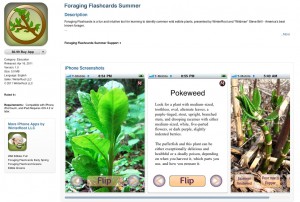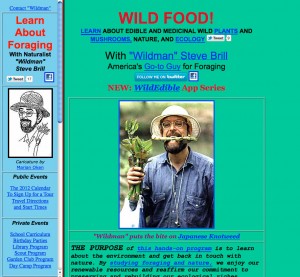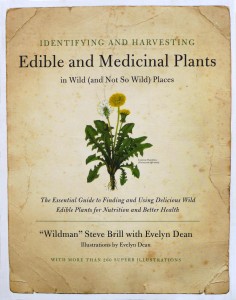Teaching experience: 30 years
Primary region: New York City, New York and surrounding states
Website
Website: “Wildman” Steve Brill
- Schedule and locations of foraging walks
- Wild plants section with links to pages describing each plant, its food uses and its medicinal uses
- Mushrooms section with links to pages describing each mushroom
- Articles
- Recipes for wild plants and for mushrooms
- TV clips, radio and other audio recordings, and a link to YouTube videos
- Online store to purchase “Wildman’s” books, etc.
- Information about the Wild Edibles series of foraging apps
Foraging apps
Wild Edibles
 Description of app (from Android site): Wild Edibles provides an intuitive and easy to use interface for identifying and using wild edible plants, drawing on the outstanding publications and extensive knowledge of “Wildman” Steve Brill.
Description of app (from Android site): Wild Edibles provides an intuitive and easy to use interface for identifying and using wild edible plants, drawing on the outstanding publications and extensive knowledge of “Wildman” Steve Brill.
+ Identify wild edibles using up to 8 images for each plant.
+ Detailed descriptions, similar plants, poisonous lookalikes, and medicinal information improve your knowledge of useful plants.
+ Harvesting methods, preparation instructions, and recipes help you prepare free foraged foods.
+ Includes botanical glossary and general foraging information.
Wild Edibles offers a massive compendium of foraging knowledge suitable for beginners and experts alike. Use this app at home as a quick reference, or in the field as a replacement for cumbersome field guides. Providing the subject’s most comprehensive resource in a compact digital form, this app takes wild edible plants to a whole new level of accessibility.
Wild Edibles Full offers full access to 165 edible plants, 52 minor lookalikes, 719 images, and 162 delicious recipes, including roots, nuts, fruits, greens and more – a tour de force for wild edibles identification and use.
Available from: “Wildman” Steve Brill’s website, iTunes store and the Android Marketplace.
Book
Identifying and Harvesting Edible and Medicinal Plants in Wild (and Not So Wild) Places
Written by “Wildman” Steve Brill, illustrations by Evelyn Dean
Copyright 1994
Published by Harper
- Chapter One: An Introduction to Foraging for Wild Plants
- Whetting Your Wild Appetite
- Why Forage?
- Where to Forage
- When to Forage
- Chapter Two: Edible Wild Plants of Mid-Spring
- Clovers
- Asiatic Dayflower
- Lady’s Thumb
- Purslane
- Wood Sorrel
- Bracken
- Burdock
- Epazote
- Pineapple Weed
- Pokeweed
- Black Locust
- Cow Parsnip
- Lamb’s-Quarters
- Common Milkweed
- Mints
- Greenbrier
- Hercules’-Club
- Wisteria
- Etc., etc.
- Chapter 3: Edible Wild Plants of Summer
- Wild Bean
- Ground Cherry
- Common Strawberry
- Common Sunflower
- Yarrow
- Blackberries
- Blueberries
- Cornelian Cherry
- Currants and Gooseberries
- Common Elderberry
- Passionflower
- Peach and Nectarine
- Pear
- Wild Plum
- Raspberries
- Sumac
- Etc., etc.
- Chapter 4: Edible Wild Plants of Autumn
- Chapter 5: Edible Wild Plants of Late Fall Through Early Spring
- Chapter 6: Edible Wild Plants of Early Spring
- Chapter 7: Cooking with Edible Wild Plants
- Wild Foods Are Different
- All Natural Cuisine
- Special Equipment
- Cleaning Wild Foods
- Preserving Wild Foods
- Unrefined and Wild Flours
- Chapter 8: Wild Food Recipes
- Appetizers and Side Dishes
- Salads
- Soups
- Breads
- Entrees
- Jams, Dressings, Spreads, and Sauces
- Desserts
Review: The list of plants covered in this book runs several pages (long — just like the book’s title). Since the book is organized by seasons, the best way to find a plant of interest is to consult the index. Brill inserts snippets of his humor and numerous anecdotes as he shares information about each plant. Some of the plants are recommended for experienced foragers rather than novices and Brill states this within his narrative. Both the text and the pencil illustrations point out identifying characteristics of a plant. The illustrations (although good) are not totally reliable for identifying a plant. You will want to consult other resources to help with learning to identify any particular plant. Brill makes note of the plant’s edible parts, its nutritional components and any known medicinal uses.
Available from: “Wildman” Steve Brill’s website and online bookstores.


